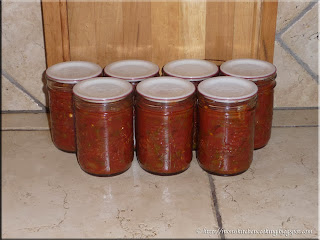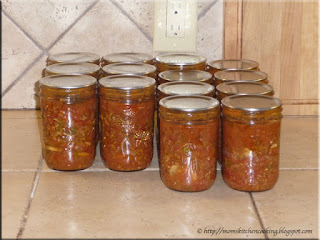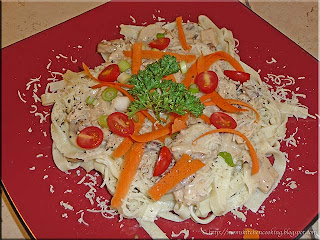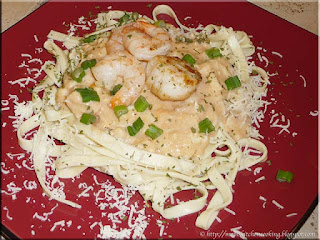Michael Smith is my favourite Canadian chefs. I am particularly fond of his wholesome philosophy of cooking without a recipe using whole foods (aka cooking from scratch). Being laid up, I have enjoyed watching a bit of Food Network Canada so was quite intrigued by his seafood chowder with dill. My dill has just been started so I have no fresh to use meaning I have to wait to try that yummy sounding recipe. What stood out was his comment that anything that swims in water is fair came for a seafood chowder. I decided to take this ideal a step further to create a roasted tomato basil seafood sauce for pasta.
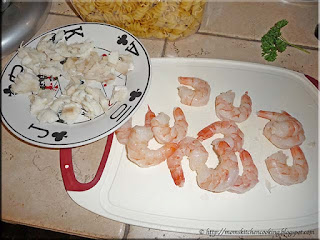
I really started this recipe with a vague idea of what I wanted the end result to be. We has recently dined at a local restaurant where I enjoyed spaghetti topped with a seafood blush sauce so that was my inspiration for this dish. I used cooked seafood in my recipe, focusing on cod, shrimp and crab meat. The premise was each would add texture and flavour without being overcooked and rubbery. I used a piece of cod fillet that was about 5 - inches long, simply brought to a boil in salted water and cooked to opaque. The shrimp was pre-cooked and frozen so all I had to do was thaw, peel and cut into pieces. It was left over from our holiday celebrations so I wanted to use up some of it.

The crab knuckle is the joint where the crab legs attach. It is a nice meaty section ideal for making seafood based soups, salads, dips and chowders. The meat is not quite as sweet as the legs themselves but there is a lot of it. One crab knuckle will give a yield of about ¾ cup of prepared crab meat. The taste difference between using the crab knuckle even cooked from frozen when compared to store bought canned crab meat is far superior!
Method for cooking: Pour about 3 cups of water into a small sauce pan. Season with about a teaspoon of salt. Bring the water to a boil then put the frozen crab knuckle into the water. Allow to cook until the meat is opaque. Remove the knuckle from the water with a slotted spoon and allow to drain before preparing.
The crab knuckle yields a nice sized piece of crab meat that has a lovely flavour. Now doesn't this piece of crab meat from the knuckle look divine? I was so tempted just to eat is as is but I resisted!
The easiest way to get the meat out of the knuckle is to use a pair of kitchen shears. Cut horizontally from across the knuckle from narrow end to narrow end. The meat shell can easily be peeled off leaving the tender, juicy crab meat. Any remaining crab meat on the knuckle can be removed using the tines of a fork. Cut the crab meat into bite sized pieces if using for soups, stews or chowder. If using for dip, shred with the tines of a fork.
Home canned fire roasted tomato basil sauce formed the base for this seafood
blush sauce. I love basil and quite frankly grow several varieties because there is no such thing as too much basil! You know that commercial where the lady says "I put the F on everything"? Well I could say the same thing about basil. The end result was a yummy, zesty seafood sauce just perfect for topping rotini. If you notice, I generally do garnish homemade pasta dishes with fresh chopped vegetables that help to add nutrition along with texture. I also garnished with a little Parmigiano Reggiano (aged over 24 months) and fresh ground pepper for flavour without adding a lot of calories or fat as well as fresh parsley for colour, flavour and digestive properties.
This sauce was a winner hands down! I think the only thing I would change the next time is to reduce the amount of the roasted tomato basil sauce. That would allow the seafood flavour to shine through a bit more. Other than that, it really was an excellent sauce perfect for topping most pastas!
Roasted Tomato Basil Seafood Sauce
recipe by: Garden Gnome
12 jumbo cooked shrimp
1 small cod fillet (or other white fish)
1 crab knuckle
2 c 2% milk
¼ c evaporated 2% milk
1½ c roasted tomato basil sauce
8 oz pk sliced mushrooms
2 tbsp extra virgin olive oil
1 tbsp butter
2 tbsp flour
2 tbsp water or milk
1 tsp
½ small onion
½ small tomato
1 sprig fresh parsley per serving
1 tbsp fresh grated Parmigiano Reggiano
fresh cracked pepper
Cook the cod fillet and crab knuckle in separate small sauce pans and cook until opaque. Cool, then cut into bite sized pieces. Sautée the mushrooms in the olive oil and butter mixture. Drain. Bring the milks to a simmer then stir in a slurry of flour and water or milk. Allow to cook until thickened. Stir in the roasted tomato basil sauce and mushrooms. Bring to a simmer. Stir in the shrimp, cod and crab meat. Remove from heat. Ladle the sauce over your pasta of choice. Sprinkle on fresh grated cheese and fresh cracked pepper. Garnish with fresh chopped onions, tomatoes and sprig of parsley.






